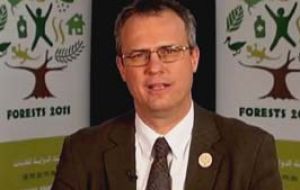MercoPress. South Atlantic News Agency
FAO sponsors protecting trees and forests in cities to improve urban live hood
 Tress needed to protect city environments says FAO Assistant Director-General for Forestry Eduardo Rojas-Briales
Tress needed to protect city environments says FAO Assistant Director-General for Forestry Eduardo Rojas-Briales Focused policies and investments aimed at protecting and managing forest and trees in and around cities are needed to strengthen urban livelihoods and improve city environments, as the world becomes increasingly urbanized.
This was the message offered Monday on occasion of World Habitat Day by the international Collaborative Partnership on Forests (CPF), of which FAO is a member.
As an increasing share of the world's population now lives in cities and their surroundings, the CPF called on countries to pay more attention to managing and protecting urban and peri-urban forests.
In addition to improving the quality of urban environments, forests in cities can also mitigate severe weather impacts by shielding buildings from strong winds and flooding and can help cities save energy by acting as a buffer from hot weather.
“The accelerating rate of natural disturbances affecting cities such as storms, droughts, floods and landslides reminds us that resilience to disasters is of critical importance and that trees play an important role in protecting city environments,” said FAO Assistant Director-General for Forestry Eduardo Rojas-Briales.
“Good practices in urban and peri-urban forestry can contribute to building a resilient city in terms of mitigation and adaptation to the effects of climate change.”
Urban forests also improve the well-being and health conditions of citizens by cooling the environment, particularly in arid zones.
“Trees and forests in cities provide urban dwellers with much needed recreational and ecological values, and during the International Year of Forests we have seen many examples of community activities in cities from tree plantings to nature hikes,” said Ms. Jan McAlpine, Director of the United Nations Forum on Forests Secretariat.
“These ‘green belts' also serve as valuable habitats for birds and small animals and create an oasis of biological diversity in urban environments.”
Additionally, urban trees afford vital ecosystem services, such as carbon sequestration and carbon storage, and can serve as a source of alternative energy.
Urban agriculture and agro- forestry, home gardens, and the harvesting of non-wood forest products like mushrooms can supplement household food supplies, but are not common practices, globally.
Urban forests can also serve as a living laboratory for environmental education in urban settings helping to bridge the gap between urbanized populations and forests.




Top Comments
Disclaimer & comment rulesCommenting for this story is now closed.
If you have a Facebook account, become a fan and comment on our Facebook Page!